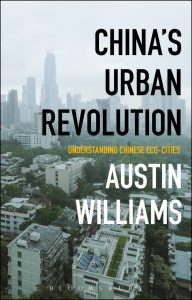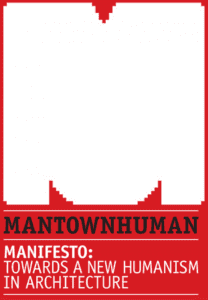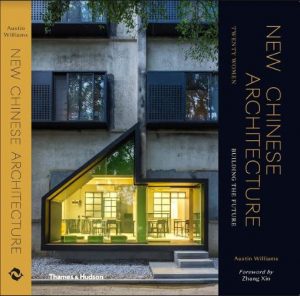Working Practices: East v West
 by Mi Ding
by Mi Ding
Even though, or perhaps because the first coronavirus case was discovered in Wuhan, China back in December 2019, China seems to be emerging first from the crisis. Many businesses have started to operate as normal and people are taking to the streets, going to work and traveling on public transport. This article looks at the situation for the construction industry in both China and UK and perhaps would be useful for those who would like to expand their experience in Asia.
The construction industry in China has many significant differences compared to UK. In recent years, Chinese clients have begun to appreciate designs that attract good reviews on social media and in the design press. They are much more open to experimental proposals and seem to prefer uniqueness even if this means extra costs and a level of difficulty in the fabrication and construction process.
To win a project, architectural practices in China have to network – I the same way that most British practices do. However, networking in China is very different (called guanxi in Chinese). Guanxi is very complicated and vague, but rather formal and can reflect connections of friends, families and schoolmates as well as powerful decision-brokers.
Many Chinese projects are based on client-centred competitions; and architectural practices usually enter the process through their guanxi network. Unlike business in UK where terms and conditions need to be agreed clearly in written contractual agreements, this is regularly not the case when agreements are made through guanxi connections. These are often oral statements with all the misinterpretation that this brings, especially if the relationships fall apart. Even when things go smoothly, once the design fee has been agreed it is very unlikely that the designer can claim any extra fees, even if additional services have been provided.
Clients have high expectations, especially about fast-track construction and this often places high demands on architects. Client prefers to have construction finished within months, sometimes even weeks. It is noticeable in China that buildings are being demolished after a decade; interior renovations are often updated within a few years. (“The average lifespan of a Chinese building is about 30 years old, compared with 135 years in the United Kingdom”*). It is very rare to find buildings that have lasted over 100 years in China. The consistent demands of construction churn provides a lot of opportunities for architects and designers compared with the reasonably static UK sector. However, architects in China have to work longer and harder in order to respond to their client’s demands.
“Efficiency” means something slightly different in China; it tends to refer to the pragmatic speed of delivery, rather than anything more profound. The modern Chinese client tends to be less patient and doesn’t want to for design services. They would expect to have design proposal in a tight timeframe and typically architectural practices have to work a lot of overtime in order to meet the deadlines.
The Chinese number “996” drew a lot of attention in Chinese social media last year. It refers to six working days a week and each working day starts at 9am and finishes at 9pm. The phrase was first created to refer working patterns in tech companies. And then “ 007” emerged for the construction industry. 007 means working for 7 days a week with no break. It’s like the Western concept of 24/7… except the Chinese mean it.
The efficiency drive in China means professionals in the construction industry (both architects and construction workers) have to work very hard to meet deadlines and it is very difficult to keep a work-life balance. In the west, this is often all architects talk about.
With consistent demands from the market, it is not difficult to find a job as an architect in China. Recruitment processes take a much shorter time compared to the UK: applications send to the recruitment team receive a reply in 1-2 days and interviews are often arranged for one or two days later. Sometimes it only takes 3-4 days to hire someone. Mind you, job security is tenuous.
 Practices in the UK are proud of focusing on employee’s personal development; Chinese practices emphasis more the unity of team. While there are stringent official policies, employment protection for employees predominantly relies on the approach of the practices, where different practices have different policies.
Practices in the UK are proud of focusing on employee’s personal development; Chinese practices emphasis more the unity of team. While there are stringent official policies, employment protection for employees predominantly relies on the approach of the practices, where different practices have different policies.
Government regulations also offer protections for employees in China. Like British employer who needs to contribute to pension scheme every month, employers in China are requested by government to contribute to employee’s “Five Insurances and One Fund” (Endowment, Medical, Unemployment, Work-related injury, and Childbirth Insurance as well as the Housing Accumulation Fund [by which an employee is permitted to withdraw money when they make property purchases]). The insurances and funds will stay in the employee’s national account even if the employee decides to change ther employment.
The office hierarchy is straightforward and obvious in China, especially in large local architectural firms. Age and presumed experience is a key differentiator for the hierarchical structure of the practice, and often young professionals have to show respect – deference – to older professionals. For instance, it is highly unlikely that the line manager would make tea for, or take tea with, the rest of the team members in China. The age-old policy of young interns making tea for thir elders and betters, with a high degree of deference thrown in, is alive and well in China.
Requesting annual leave is also different. In Chinese practices, employees often need to have a specific reason (such as visiting their families in the hospital) to request holidays, and approval for leave will be based on the reasons being given. At least it’s not as bad as the old danwei communal work unit system which, until 2003, required workers to seek permission before getting married or divorced
Compared to the UK, the way that Chinese businesses approach architectural projects in China might – through informal networks and unwritten contracts, etc – might seem to pose high-risks for all parties. However people tend stick with the moral sentiment embodied in the agreement and value the relationship of connections even there is no written agreement; hoping maybe that it’ll be confirmed at a later stage.
Perhaps this is a more trustworthy approach? It seems to work reasonably well for projects that need an immediate start as it skips over the time needed to faff about with complicated contracts. However, it undoubtedly leaves major uncertainties for practices when disputes invariably arise. It is noticeable that practices founded in recent years (especially for those who have oversea background) have started to push the importance of a written agreement.
With the incredible urbanisation of China over the past 20 years, fast truck construction service has created many ‘miracles’ that seems unlikely to have happened in UK. It clearly provides a quick solution of many basic needs for a nation with such a large population. Rapid responses while valuing of team has demonstrated a capacity to rebuild society from the dark days of the 1970s.
It’s very difficult to predict and assess the risks and responses should an emergency like Covid19 happen, even for a developed construction industry in the UK which has many years’ experience of risk assessment and time management. Perhaps a combination of both working pattern that could provide flexibility ways of working under different situation would be an option in such a changing, globalised world.






